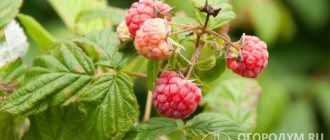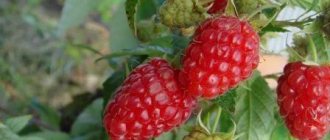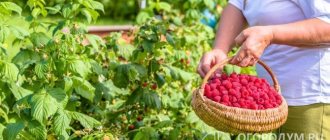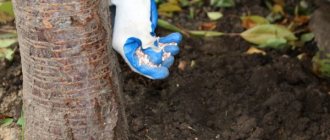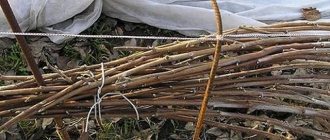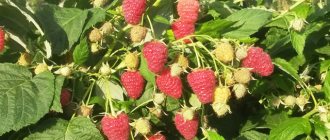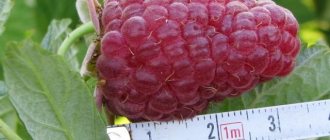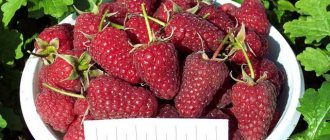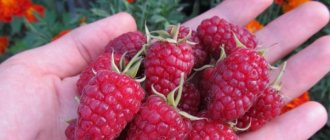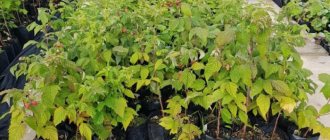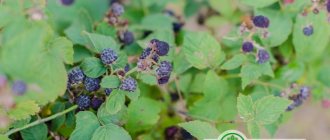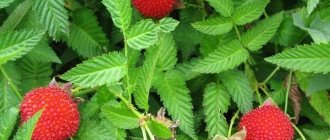History of selection
Golden Autumn is a raspberry of Russian selection. At the beginning of this century, this elite variety was obtained by employees of the Kokinsky stronghold of the All-Russian Selection and Technological Institute of Horticulture and Nursery Growing (Bryansk Region) through free pollination of the selected form 13-39-11. The work was led by famous domestic scientists Ivan Kazakov and Sergei Evdokimenko, and for the latter, raspberry cultivation is the main area of specialization.
In 2001, the sample was given its own number 24-129-2, and three years later it began to be purposefully bred as an independent variety. Golden Autumn was included in the state register of breeding achievements in 2008 and recommended for gardening (not industrial) cultivation throughout the Russian Federation.
Did you know? Yellow raspberries first began to be cultivated in the 20s of the last century and initially gained a very dubious reputation: its fruits were small, crumbled and broke. However, in terms of frost resistance, these varieties always outperformed the red ones, and when American and English breeders managed to develop several elite yellow-fruited varieties, attitudes towards them changed dramatically.
In the little over a decade that has passed since the appearance of the new variety on the market, it has managed to win many fans, although it is cultivated mainly in the central and southern regions of Russia (Belgorod, Bryansk, Vladimir, Voronezh, Ivanovo, Kaluga, Kursk, Lipetsk, Moscow, Oryol , Ryazan, Smolensk, Rostov, Tambov, Tula), Dagestan, Adygea, Ingushetia, Kabardino-Balkaria, Alania, Chechnya, Stavropol and Krasnodar Territories.
In addition, Golden Autumn has been perfectly adapted in some countries near and far abroad, in particular in Belarus, Lithuania, Latvia, Estonia and Ukraine. The warm climate of Crimea is also excellent for growing raspberries and allows you to get a very good harvest from each bush.
History of the origin of the remontant variety
This unusual variety was obtained by Russian breeders. That is why it is perfect for our vegetable gardens. The variety was obtained in the Bryansk region, where a large number of new species of raspberries come from. Its creators are wonderful domestic scientists I. Kazakov and S. Evdokimenko.
The variety is bred on the basis of:
- elite varieties of raspberries;
- free pollination;
- use of remontant varieties for breeding.
Description and characteristics
The description of the variety should start with the bush. In Golden Autumn it does not grow too tall - only up to 1.5–1.6 m and has from 5 to 7 shoots of medium thickness. In the first year of life they are green and, in the absence of a garter, often bend towards the ground, but already in the next year they become lignified and become erect. The fruiting part of each shoot occupies more than half of its length. The thorns are located at the base of the branches, and their number is small. In the lower part of the bush the branching of the branches is high, but in general the plant is not too spreading and quite compact . The leaves have a bright emerald color; their characteristic feature is also pronounced wrinkling.
Did you know? In terms of its chemical composition, red raspberries compare favorably with yellow ones; our rare black and purple berries are considered even more useful. The first (black) were bred by the Americans, the second (purple) were obtained in Switzerland by crossing varieties with red and black fruits.
The berries have a slight pubescence, an elongated cone-shaped shape and a beautiful golden color, justifying the name of the variety. The taste of the fruit is dessert, but in addition to the usual sweetness there is added a slight sourness, characteristic of yellow raspberries and explained by the presence of more vitamin C in the fruits (compared to red berries). The drupes are small, and when biting they are almost not felt, so children eat raspberries with pleasure . The pleasant and balanced taste is also complemented by the exquisite aroma that Golden Autumn raspberries possess. But in general, the tasting rating of the berries is not very high: due to the presence of sour notes in the taste, on a five-point scale the fruits are rated only 3.9 points.
This variety cannot be called large-fruited either. The average weight of one berry is 4.5–5 g. With proper rationing (removal of excess ovaries) and good agricultural technology, larger fruits, up to 7 g, can be found on the bush, but such specimens are still rare.
Due to the dense structure of the berry, the raspberry variety in question is distinguished by its ability to hold well on the branch and not lose shape when picked . This circumstance makes the berries suitable for storage and transportation, and also determines their universal use: Golden Autumn raspberries are equally well suited for fresh consumption, canning and freezing whole.
Description
The Golden Domes raspberry variety was created by Russian breeders. Today it is on the State Register lists. It is recommended to grow a remontant plant in the Central region of Russia, but self-fertile raspberries have long crossed the proposed boundaries.
Bushes
The variety Golden Domes is remontant, with medium branching, spreading. The height of the bush varies between 1.3-1.5 m. The growth of erect shoots is moderate, which has a positive effect on care. There are few offspring of the first year on the raspberry variety; they are easy to distinguish by their light green color and slight pubescence and waxy coating. In addition, they are much thinner than two-year-old shoots. On two-year-olds, the bark is soft brown.
Sheet plastic is medium in size, rich green in color. Slight pubescence and wrinkling are present. Raspberry leaves of the Golden Domes variety are slightly curled.
Fruit
The variety's berries are hemispherical, weighing up to 3.8 grams. They are located on a short stalk and are easily separated. The particles will not separate when picked and processed; the raspberry fruits retain their integrity. The berries are slightly pubescent; at an early stage of ripening they are yellow; when slightly overripe, they take on the color of an apricot.
Important! Yellow raspberry fruits do not cause allergic reactions, so they can be safely included in the diet of children and pregnant women
The fruits are tender, juicy with subtle notes, somewhat different from the usual raspberry taste: the berries of the Golden Domes variety are sweet and sour. If we consider the composition, then raspberries contain 13.8% dry matter, sugar 6.4%, ascorbic acid C 17.8 mg/%.
Productivity
According to the description of the variety, reviews from gardeners and photos sent, fruiting of remontant raspberries Zolotye Domes is abundant. You can see this for yourself.
As a rule, with proper care and compliance with agricultural practices, more than two kilograms of amber berries are harvested from a remontant raspberry bush. Farmers set the yield level at 100 centners of raspberry varieties per hectare.
Advantages and disadvantages
- Gardeners managed to appreciate Golden Autumn thanks to the following advantages of the variety:
- beautiful appearance, regular shape and bright color of the fruit;
- rich vitamin composition of berries (high content of ascorbic acid);
- lack of tendency to fall from the bush and scatter into segments during harvesting;
- long fruiting period;
- ability to adapt to different climatic conditions, large zoning area;
- excellent transportability and keeping quality of berries;
- universal purpose of fruits.
- Among the disadvantages of the raspberry variety in question are usually noted:
- the berries are not large enough;
- relatively low tasting scores of fruits;
- mediocre yield indicators;
- average frost resistance;
- lack of drought resistance;
- rather weak immunity to diseases and pests.
Drought resistance, frost resistance
Golden Autumn reacts to drought with a sharp decrease in yield, so abundant and proper watering is a prerequisite for cultivating the variety.
This raspberry is also not distinguished by increased . Even with good agricultural technology and proper preparation for winter, the critical temperature for the root system and fruit shoots is below -22°C. The bush can tolerate more severe weather conditions (temperature drops to -30°C), but only if such a cold spell does not last long and is not accompanied by sharp transitions from severe frost to thaw.
Important! In the context of a personal garden, the advantages of Golden Autumn compensate for all the disadvantages associated with its cultivation, but professional farmers still recognize the cultivation of this variety as unprofitable.
Productivity and fruiting
Golden Autumn is a classic example of a remontant raspberry . The bush enters the fruiting phase at the end of June or July (depending on climatic conditions), then after a short break, by mid-August or early September, the plant begins a second wave of fruit set, which, under favorable conditions, can continue until late autumn.
Like all remontant varieties, Golden Autumn does not have record yields. But good care allows you to remove an average of 2 to 2.5 kg of berries from one plant.
Video: Raspberry variety Golden Autumn
Reviews
Golden autumn, with its unpretentiousness, undemanding nature and generous harvests of attractive and healthy berries, has won well-deserved love and popularity among gardeners.
- It seems to me that Golden Autumn is the best remontant type of raspberry! In the first year I planted only 3 bushes, in just two years it grew and a small plot was planted. I make sure to prune and fertilize in the fall, and in September - October we collect the aromatic berries.
- A neighbor at his summer cottage gave his husband several young shoots of Golden Autumn raspberries. We couldn’t even imagine that we would be so happy with every bush! Excellent yields with minimal care. Very aromatic and sweet berry
- Excellent variety of raspberries! For the fifth year now we have been pleased with good harvests. All autumn, until frost, there are fresh raspberries on the table!
Although raspberries are not a demanding plant, only with proper care and attentive attitude will they please the owner with a magnificent harvest of fragrant golden berries.
Landing Features
Agrotechnical rules for planting Golden Autumn raspberries can be called standard, but some features must be taken into account based on the climatic zone within which it is planned to grow the fruit subshrub.
Deadlines
There are two options for planting raspberries - in early spring and in the second half of autumn. The bush will overwinter much easier and then grow faster if it is planted in the fall, but this rule only works if the climatic conditions do not imply harsh and snowless winters with sharp temperature fluctuations. Therefore, traditionally in the southern regions and the middle zone it is better to plant raspberries in the fall , and for areas with a colder climate, spring planting is used.
Learn about the features of autumn planting raspberries.
When choosing specific calendar dates within a season, you should be guided by two standard rules:
- In spring, fruit bushes are planted in such a way that the buds begin to bloom after the plant is in the ground.
- In autumn , on the contrary, it is advisable to wait until the bush loses its leaves, otherwise the young shoots that begin to develop after planting will freeze in winter, and this negatively affects the overall winter hardiness of the plant. On the other hand, it is also impossible to be late with planting: the root system of the seedling must have enough time to establish itself in a new place. The best option is to guess the moment when there are about 3 weeks left before the first real frost.
Choosing a suitable location
One of the main secrets of a successful raspberry plant is the correct choice of place for planting it. Here it is important to comply with several requirements:
| Lighting | Maximum and uniform (rows are best placed from south to north) |
| Optimal groundwater depth | 1.5 m (if this parameter is less than 1 m, good drainage or a water drainage system is required) |
| Openness of the site | Raspberries are afraid of strong gusts of wind, so the area should be well protected, but air stagnation is also not allowed |
| Height and levelness of the site | The lowland is not suitable for shrubs due to the accumulation of cold air masses here, especially in winter, but at higher elevations the risk of the area being blown by the wind increases. The slope is allowed, but it must be gentle and, if possible, north |
| The soil | Light, fertile, with a neutral or acidic reaction. Sandstone, sandstone or chernozem are well suited. Clay, sand and limestone, as well as waterlogged soil are excluded |
| Good neighbors | Onions, garlic, peonies, marigolds |
| Bad neighbors | Tall trees, strawberries, strawberries, blackberries, meadowsweet |
| Good predecessors | Legumes, pumpkin |
| Bad Predecessors | Nightshades, strawberries, wild strawberries, sunflowers |
Selection and preparation of planting material
When choosing a seedling of a fruit tree or shrub, it is important to follow two fundamental rules:
- The seller must be trusted and have a good reputation (the best option is a professional gardening nursery).
- The place where the seedling was grown should be geographically as close as possible to the point of permanent location of the bush (transplantation).
Even Golden Autumn, which is not highly winter-hardy and drought-resistant, will take root much more easily in an extremely hot or, on the contrary, quite cold climate , if it was originally grown in these conditions. At the same time, a seedling brought from afar to a more favorable region has much less chance of successful development.
The selection technology is simple: the seedling must look absolutely healthy and have no visible damage. The presence of leaves on a young bush is not welcome - through it the plant loses a lot of liquid, which means it may be weakened
Golden Autumn, like all remontant raspberry varieties, can be planted at the age of one or two years. In the first case, the bush consists of 1 or 2 green shoots 30–40 cm high. A two-year-old seedling can have the same height, but its shoots are lignified and thicker (7–8 mm), and the root system is quite well developed. In both the first and second cases, a sign of good viability of a bush is the presence at its base (where the root meets the trunk) of at least one, or preferably several, powerful green buds . It is from these that young fruit shoots will subsequently begin to form.
Also find out how to transplant raspberries to a new place in the spring.
Landing algorithm
The technology for planting Golden Autumn raspberries is traditional and does not depend on the season or the age of the seedling. The algorithm looks like this:
- Dig a hole measuring 45x45x45 cm. The given parameters are approximate and can be adjusted depending on the size of the root system of the seedling, as well as the initial state of the soil (the less suitable it is for growing raspberries and the more it needs improvement, the deeper and more voluminous the planting hole should be) .
- Divide the soil removed from the pit into two parts: the top layer will be used in the future, the bottom layer is removed as infertile.
- Thoroughly mix the prepared part of the fertile soil with organic fertilizer, for example, humus or compost - about 10 kg of such organic matter will be needed per bush.
- Add to the resulting mixture mineral fertilizers containing potassium and phosphorus, for example, 100 g of superphosphate and 50 g of potassium sulfate (wood ash can be used as potassium fertilizer, but its amount must be increased to approximately 400 g).
- Return a small part of the nutrient soil mixture to the bottom of the hole and rake it towards its center in the form of a mound.
- Place the seedling on the surface of the formed hill and carefully spread its roots along the slopes.
- Fill the hole with the remaining soil, compacting it thoroughly.
- Form low sides of soil around the circumference of the trunk area and water the bush generously.
- When the water is absorbed, mulch the soil around the plant with peat, sawdust or coniferous “substrate” (rotten needles mixed with sand, which can be collected in a coniferous forest).
When planting several bushes, the standard distance between them should be maintained - at least 40 cm should separate one plant from another in a row, and if there is more than one row, you need to ensure a minimum row spacing of 1.5 m
Planting and growing technology
Since Golden Autumn is a remontant variety, the shoots produce a harvest already in the first year, the most optimal time for planting the crop is early spring or September - October, the time immediately after harvesting. When planted in autumn, by spring the seedlings will have time to take root well and please with a decent harvest of ripe, juicy berries. In spring and summer, during the growing season, it is not recommended to replant plants, as they may not take root.
For planting, you should select healthy young shoots - annuals, with a uniform green color of the stem and a developed living root system.
Despite the fact that the variety is frost-resistant, it is better to choose a well-lit place for planting, on the south side of buildings, fences, front gardens - after all, any raspberry does not like drafts and shaded places.
The soil for planting raspberries needs to be prepared in advance: dig up, remove all weeds, be sure to apply fertilizer (per 1 m2 add 2 buckets of rotted manure + about 300 g of mineral fertilizers). If the soils are acidic, be sure to add fluff lime or 200 g of ash per 1 bucket of organic fertilizer.
Raspberry Golden Autumn most fully displays all its positive qualities on neutral, fertile soils of light structure, and responds well to fertilizers and fertilizing.
Raspberries can be planted as individual bushes or using the trench method. The distance between bushes should be at least 50 cm, between rows - 120 cm, planting depth - to the level of the root collar. The roots of the shoots are lowered into prepared trenches or holes, sprinkled with earth, lightly compacted, and watered at the rate of 5 liters per bush. The soil around the seedlings is mulched with peat and humus.
Good predecessors for raspberries are green manure plants, mustard, lupine, as well as rye and peas. It is not advisable to plant Golden Autumn after potatoes, peppers, tomatoes - the yield of berries may decrease.
Care
Golden autumn requires the same care as any remontant raspberry. Amendments should be made only for the low drought resistance of the variety and its lack of pronounced immunity against diseases and pests.
In order for the bushes to develop well and bear fruit, during the growing season it is necessary to ensure the following agrotechnical measures:
- Watering. Raspberries need to be watered infrequently, but abundantly. The plant makes maximum demands on moisture during the period of active growth of green mass (April - May) and flowering (June and then August). At the moment when the bushes are filled with berries, the intensity of watering must be reduced, otherwise the fruits may begin to rot.
- Loosening the soil. The procedure is necessary to retain moisture in the soil and prevent the formation of a dense crust that prevents the penetration of oxygen to the roots. When using drip irrigation, there is no need to loosen the soil, since in this case the water enters the ground in doses, without forming puddles, and therefore the top layer of soil remains fluffy.
- Weeding. Weed control is very important because they compete with the fruit bush for nutrients in the soil and, in addition, are reservoirs of various infections. You can solve the problem once and for the whole season by mulching, covering the soil around the bushes with a thick layer of peat, sawdust, straw or freshly cut grass.
- Trimming. Remontant raspberries need to be pruned in autumn and spring, leaving only the strongest and youngest shoots.
- Feeding. Remontant varieties need more fertilizer than ordinary ones, but you still cannot overdo it with these procedures. In the spring, raspberries are fed with urea, ammonium nitrate or other preparations containing nitrogen, and in the summer the emphasis is on phosphorus and calcium. To increase the yield in the fruiting phase, it is useful to spray the bush with boric acid (10–20 g per 10 liters of water); in the fall, the raspberry tree is enriched with organic matter (1 kg of humus or compost per bush), as well as potassium and phosphorus fertilizers (superphosphate, potassium sulfate etc.).
Raspberry care
Although the Golden Autumn raspberry is quite unpretentious, there are a number of agrotechnical procedures for caring for bushes of this variety that must be followed:
- Watering the bushes is carried out at least once every 7 days. In this case, it is necessary to ensure that the soil is saturated with moisture to a depth of at least 0.3 m; in dry, hot weather, the number of waterings is increased.
- Loosening of the soil is carried out regularly, preventing the formation of a crust on the surface of the soil after watering. This procedure saturates the soil with oxygen while removing weeds.
- If you apply fertilizers before planting Golden Autumn shoots, the plants will not need fertilizing for two years. And only from the third season can you apply organic fertilizers to the bushes: humus, compost or manure (in liquid form). Organic matter should be added to the raspberry garden several times a season. In the spring, after massive snow melting, you can apply complex mineral fertilizer to the bushes of this berry crop.
- Golden Autumn raspberry bushes should be pruned in the autumn, after the harvest is complete. In this case, all shoots are cut at the root. Next season, when young shoots appear, all weak shoots should be removed.
Harvesting and storage
The dense berries of Golden Autumn have good shelf life, but to increase shelf life, the crop must be harvested in dry weather and not washed until consumed. In this case, raspberries can remain in the refrigerator for up to 15–20 days, almost without losing their freshness . However, if the crop is planned to be processed, it is advisable to do this as soon as possible after harvest, since each day the fruit is stored reduces its nutritional value and increases the amount of waste.
Beautiful and well-shaped Golden Autumn berries are great for freezing, so if the housewife doesn’t have time to prepare compotes and jams, they can be prepared for the whole winter in literally a matter of minutes.
Read more about how to properly freeze raspberries.
Absolutely dry berries should be frozen; after washing, it is almost impossible to dry raspberries while maintaining their original appearance. Therefore, for this type of preparation, it is better to select the cleanest fruits hanging on the upper branches, which can be consumed unwashed.
In addition to traditional harvesting methods, you can make excellent wines and liqueurs from raspberries. Experts argue about the suitability of white varieties for these purposes, but among winemakers there are those who consider such drinks to be a very worthy alternative to classic white wine. In addition, raspberries blend well with other berries, such as currants, gooseberries or cherries.
Watering
Golden Autumn raspberries love moderate humidity; it is advisable to water them with warm water, approximately once a week, making sure that the soil is moistened to a depth of about 30 cm. The lack of a sufficient amount of moisture negatively affects the size of the berries and the amount of harvest.
Watering is alternated with loosening the top layer of soil. The first loosening is carried out during the swelling of the buds, this will saturate the soil with oxygen and make it lighter. Further loosening is carried out as needed, taking into account the condition of the top layer, simultaneously with the removal of weeds.
Preparing for winter
The low frost resistance of Golden Autumn necessitates careful preparation of the bush for winter. These activities include:
- removing all leaves from each shoot (moving from bottom to top so as not to damage the fruit buds);
- cleaning the soil within the raspberry patch from all remaining organic matter (fallen berries, leaves, weeds), which is a traditional wintering place for pests;
- pruning all fruit-bearing two-year-old shoots (annual shoots of remontant varieties are not pruned, since they will bear berries next season), as well as damaged, diseased and weak branches;
- abundant watering of the bush to prevent the soil from freezing (water consumption should be one and a half times higher than the usual rate) - in dry soil, the root system tolerates frost more difficult;
- bending all the shoots remaining after pruning to the ground and attaching them with pins.
Important! Raspberries will survive the winter much easier if not only its root system, but also the above-ground part with fruit buds are under snow cover.
If the climate in the region where Golden Autumn is cultivated involves winters with a lot of snow, the gardener will need to provide the highest possible snowdrifts around each bush after the first snowfall. Ideally, the snow should completely cover the branches bent to the ground . In the case of short thaws, it is also important to ensure that an ice crust does not form on the surface of the snowdrift (the ice in this situation must be broken, otherwise the plant will rot from the lack of oxygen).
But if there is a risk of little or no snow in the winter, the raspberry tree needs to be covered in the fall. After the first frosts, which the bush must survive uncovered for hardening, burlap, agricultural fiber (spunbond) or other air-permeable material should be laid over the shoots bent to the ground , and it is fundamentally important that it be light.
We recommend that you learn more about how to prepare remontant raspberries for winter.
The edges of the bedspread can be secured with pins or any oppression, and on top, if desired (depending on how severe the winters are in the area), lay a layer of organic matter, for example, fallen leaves. Such a shelter must be removed at the beginning of spring , before the “living creatures” hibernating in the foliage (fungal mycelia, pest larvae, etc.) awaken from hibernation.
Peat, sawdust or pine spruce branches can also be used as a covering material. In this case, they can be laid directly on the shoots, without an additional layer
Reproduction
There are no problems with the propagation of this variety - the bushes produce a large number of young shoots. They can be dug up and used as seedlings. There are two optimal periods for planting - spring and autumn. Residents of the southern regions prefer the second option, since a mild winter will prevent young plants from dying. Next year, the young bush will grow faster and produce a rich harvest.
If you are just looking at this variety and decide to purchase seedlings from a nursery, then your task is to choose the most viable plants.
Please note the following:
- check the roots - they should not be dry;
- It is advisable to choose the shoots themselves straight, with a healthy stem;
- the root system can be open or closed.
Reproduction methods
Raspberries grow very quickly without outside help, sending out numerous root shoots. Therefore, when planting bushes, they need to be carefully fenced, digging a fence to a depth of at least 50 cm, otherwise after a few years the gardener will face the real problem of the bush taking over an area not intended for it. On the other hand, these root shoots are excellent for propagating raspberries .
Did you know? From a botanical point of view, raspberries are not a berry. Moreover, this is not even a fruit, but several dozen fruits firmly fused together, each of which contains its own seed - the so-called polydrupe.
Thanks to the shallow root system that the bush has, the shoot is very easily dug out of the ground, after which it can simply be transplanted to a new location using standard technology for planting raspberry seedlings. This can be done throughout the growing season , but it is better to choose a time that is not the hottest and driest, so that it is easier for the young plant to take root.
Another way to propagate raspberries is by dividing the bush . This method is a little more difficult to implement, but when working with elite varieties, which include Golden Autumn, it is used quite often, since the number of root suckers in such raspberries is not so large. An adult plant is carefully dug up and divided with a sharp knife, starting from the root, into 4–5 parts, after which each of them is planted in a separate hole.
Finally, the most labor-intensive method of propagating a bush is cuttings . In this case, shoots obtained as a result of pruning are used as planting material. They are soaked in a growth stimulator, planted in a peat mixture and covered with film, and after the plant takes root, they are transplanted to a permanent place.
Seed propagation of raspberries in relation to the Golden Autumn should not be considered . Besides the fact that this is too troublesome, bushes grown from seeds do not retain the properties of the parent plant. For this reason, elite varieties cannot be reproduced using this method.
Planting bushes
There are different ways to plant raspberries. To do this, dig long trenches or separate holes. There should be at least 1.2 m between the rows of bushes, and approximately 0.7 m between the raspberries themselves. The depth of the hole is determined individually according to the height of the bush. The main thing is that the root collar is on the surface of the soil.
Bushes with a closed root system need to be watered abundantly so that it gets wet and the seedling can be removed. Then the bush is lowered into the prepared hole, covered with earth, compacted a little and watered thoroughly. After this, it is necessary to mulch the soil using peat.
Saplings with an open root system are planted in the same way, only before this the bush needs to be dipped in a solution of water and growth stimulants for a couple of days. Reviews from gardeners confirm that “Golden Autumn” raspberries bear fruit well only if they are properly cared for and planted.
Diseases and pests
The low immunity of Golden Autumn to diseases and pests requires the gardener to pay special attention to the issue of preventive treatment of bushes. The procedure should be started in early spring, before the buds have yet opened, and then before the fruit begins to set, carry out another 2-3 sprayings.
Important! During flowering, raspberries cannot be treated with pesticides, so preventive procedures should be carried out before flowering begins or postponed until its completion.
When choosing a drug for treatment, care should be taken to ensure that it has a fungicidal (antifungal), insecticidal (pest control) and acaricidal (against ticks) effect, since Golden Autumn can be attacked by all three types of pathogens. Some modern products (for example, “Brunka”, “Oleokuprit”, “Sulfarin”, etc.) make it possible to provide comprehensive protection to the bush, although drugs with a narrower focus are more common.
Examples include:
| Fungicidal preparations for raspberries | Insecticidal preparations for raspberries | Anti-tick medications |
|
|
|
Golden autumn - raspberries, which, with good care, can become the real queen of a summer cottage. This variety is not distinguished by either a large harvest or large berries, but it bears fruit from mid-summer and, after a short break, almost until frost. The fruits store well and can be used in any form, including frozen. But still, for summer residents who rarely visit their garden plots, Golden Autumn is not suitable: the variety is quite demanding to care for, needs regular watering, fertilizing, as well as preventive treatments against diseases and pests.
Advantages of the Golden Autumn variety
Golden Autumn raspberries are valued by gardeners for their pleasant taste, delicate aroma and long fruiting period. Its undeniable advantages:
- high productivity;
- good resistance to frost;
- high immunity – an above-average indicator of resistance to typical diseases and pests.
Despite the fact that the variety arose relatively recently, it has become widespread in the household plots of Russians.
Care and cultivation
Considering that the main part of the Golden Dome raspberry harvest is concentrated on the upper part of the shoots, in the fall, they bend strongly to the ground under the weight, therefore, so that the branches do not break and the berries are not dusty and covered in dirty splashes, immediately after planting it is recommended to equip This raspberry has low supports for a garter.
Watering
The root system of the Golden Domes variety is superficial, so the bushes react painfully to the lack and excess of moisture in the soil. Particular attention should be paid to watering during flowering and fruit set.
It is important to remember that the soil in the raspberry garden must be moistened to a depth of at least 35-40 cm
Trimming
If Golden Dome raspberries are grown in a two-year cycle, then in spring and autumn it is necessary to carry out sanitary pruning of the bushes, i.e. remove dry, damaged, weak and fruit-bearing branches. During the season, there is no need to trim green shoots, their tops, or standardize flower stalks for this variety. If the variety is grown in an annual cycle, then before winter, before frost, all shoots are removed flush with the ground, the soil in the raspberry field is covered with peat or humus, the branches are taken out and burned.
Feeding
If fertilizers were applied to the site of the future raspberry tree before planting, as well as to the planting holes, then there is no need to feed it for the first 3-4 years. However, in subsequent years, regular feeding will be critical. In early spring and late autumn, you need to add rotted manure and compost to the soil. Before flowering and the beginning of fruit set, feed the Golden Domes with mineral fertilizers - potassium and superphosphate at the rate of 40-60 g, or wood ash at the rate of 0.5 kg. for one bush. Combine regular watering with fertilizing with herbal infusions.
Preparing for winter
Removing the above-ground part of the Golden Domes raspberry solves the problem of shelter from cold weather, winds, and rodents. Only the rhizome of the bush will overwinter, so the ground in this place is covered with humus, peat or sawdust. If the bush is left until winter, then this raspberry will not withstand frosts below 22-25 degrees. Covering measures are necessary: the bushes are bent to the ground, the root zone is covered, the branches are covered with any garden material. The best shelter is snow; from the beginning of winter the bushes are liberally covered with it.
Reproduction
The raspberry variety Golden Domes produces quite a bit of root shoots, so when weeding and loosening the soil under the bushes, you need to be careful not to destroy the shoots. They are separated from the main root with a shovel and, together with a lump of earth, are transplanted to a new place. For propagation, root shoots with buds are also used; they are grown separately, and green cuttings of young shoots are also used, which are grown in a greenhouse or under jars on the shady side of the building.
Trimming
A distinctive feature of remontant raspberry varieties is the ability to produce a bountiful autumn harvest on annual shoots. To make the most of this opportunity, it is necessary to carry out autumn pruning of bushes completely to zero. It is best to prune remontant Golden Autumn raspberries in late autumn, before the onset of cold weather.
After harvesting the raspberries, all the nutrients from the shoots will have time to saturate the root system, which will have a positive effect on next year’s harvest. There is no need to leave stumps; the shoots are cut out at the root and the plantings must be mulched with straw, hay, and dry leaves. In spring, young shoots must be checked and the weakest and damaged ones removed so that the plant does not waste energy in vain.
Growing and care
The absence of problems in cultivation makes this variety increasingly popular among modern gardeners. However, for favorable growth, one should not forget about the most important agricultural practices.
Watering
The rhizomes of Nugget are located no deeper than 35 cm. The variety is tolerant of minor droughts during the summer. However, during the period of fruit formation, it is recommended to water raspberries regularly and abundantly. In addition, evening and morning spraying will not be superfluous, which will help to favorably tolerate dry air in the hot summer.
The critical air humidity for Nugget is considered to be 40%. With a sharp decrease in humidity, ground shoots require daily moisture.
Trimming
Remontant raspberry Nugget needs regular pruning. If gardeners aim to get one autumn harvest, in the fall all the stems are cut off at the root. This pruning also protects raspberries from the spread of harmful insects and diseases, and simplifies the preparation of raspberries for winter.
If raspberries are grown using the technology of ordinary garden raspberries, then in the fall all fruit-bearing shoots are cut out flush with the ground, and the young shoots are bent down to protect them from frost. The trunks that are not pruned in the fall undergo a thorough check in the spring: dried, diseased, broken branches are cut out. For 1 sq. m. there should be up to 14 shoots, per bush - up to 6 stems.
Top dressing
Nugget, like any other remontant variety, intensively consumes nutrients from the soil, so the soil must be well fertilized.
The first feeding is carried out in the third year of the bush’s life. Until this time, the raspberries will have enough nutrients added to the trench during planting.
In the spring, nitrogen fertilizers are applied to the Nugget variety. This can be urea or mullein solution, diluted in a ratio of 1 to 4 with water.
In summer, potassium supplements are relevant, which allow you to get good berry harvests. The most commonly used is potassium salt.
In the fall, phosphorus (most often Superphosphate) is added, which helps raspberries better prepare for winter and tolerate the dormant period well.
After applying any fertilizer, the plants are thoroughly watered to avoid burning the root system.
Preparing for winter
Raspberries need mulching. An impressive layer of peat, straw or dry humus will not only protect the root system from freezing, but also enrich the crop with nutrients for the next season.
Despite its winter hardiness, the Nugget raspberry needs additional shelter in frosts above -30° C, as well as in snowless winters. In these cases, experienced gardeners bend the stems to the ground, manually sprinkle them with snow or cover them with agrofibre.
How to plant remontant raspberries correctly
Planting raspberries can be done in several ways.
Everyone individually chooses what suits them. For this, the following options are used: dimple; grooved; trench; bush; capacitive.
All methods have been tested and are quite effective. The choice depends on whether you have enough strength to dig a trench or whether it’s easier to make holes. Depending on the size of the planned plantation, the possibility of how to properly fill the recesses with fertilizers.
Planting in containers
This is an excellent option when there is a shortage of land on small plots. To do this, you can use any unnecessary barrels or buckets with a diameter greater than 50 cm. The bottom is removed. The container is buried in the ground and at the same time filled with fertile soil mixed with fertilizers.
Trench planting method
The advantage of trenches is their long service life. Having mortgaged a plot, be sure that it will serve you for at least 10 years. This method frightens many because it is labor intensive. But for obtaining high future yields, it is considered the best. A sufficient amount of fertilizer is applied evenly into the trenches. They need to be prepared 3 weeks before planting. To do this, the place of the rows is marked with pegs. The most optimal trench sizes:
length –4-5 m; width – 60 cm; depth – 45cm.
A specially prepared soil mixture or nutrient mixture is added to the hole. Rotted manure or compost is placed at the very bottom. Under no circumstances should fresh manure be used. It will burn out the roots of young seedlings. Superphosphate and potassium salt or wood ash are evenly scattered on top. And at the very top is biohumus or vermiculate. Add a little of the removed fertile layer and mix with a shovel.
The roots are well spread out when the seedlings are placed in a trench. Make sure that they do not bend upward. Sprinkle with soil evenly; it should penetrate well between all the roots. Hold the seedling with your hand, trying to ensure that the level of the root collar is positioned correctly. Its optimal location is level with the surface. Deepening will lead to poor growth and even death. A high location will cause the replacement buds to dry out or freeze.
Planting is completed with watering and mulching. For good root survival, mulch is a must. It will prevent excessive evaporation and make the soil loose.
Planting in pits
An easier way. Well suited for fertile lands, when you do not need to add a lot of organic matter and minerals to feed the roots.
The recesses are made measuring 40*40*40 cm. The distance between them is 70 cm. The distance between the rows is at least 1.5 m. Before planting, you can keep the roots of the seedlings for a couple of days in water with a stimulator. This will revive their root system and increase survival rate.
The planting material is placed in the hole and the level of the root collar is monitored, filling the hole with soil. It should be flush with the surface. If the soil is sandy and can settle significantly, then the neck is deepened by 2-4 cm. Water the raspberries well. Each bush requires 5 liters of water. And sprinkle with mulch 7-10 cm thick.
Bush method
The planting scheme is carried out in such a way that the following distances are maintained:
1.2 m between adjacent bushes; 1.6 m between rows.
By the 3-4th year of cultivation, the bushes become lush and highly productive. They are easy to care for and convenient to pick berries. When pruning, up to 10 strong shoots are left in each bush. Weak and diseased branches are removed during pruning.
Furrow or row method
The shoots are planted in furrows up to 40 cm deep. The entire root system of the seedlings should fit into them. If fertilizers were not applied when digging the soil, they should be applied to the furrow. To do this, use: compost, superphosphate and potassium salt. Planting material is placed in a row at a distance of no closer than 70 cm. The correct straightening of the roots and the level of the root collar are monitored. Sprinkle with top fertile soil.
Landing
The Indian Summer variety is best planted in places where there is a lot of light and protection from the north wind. The southern side of the site, adjacent to the house or other buildings, which will protect the raspberry bushes from drafts, is suitable
It is important that groundwater is no higher than 150 cm from the surface of the earth, since excess moisture will destroy the plant
It is not recommended to plant raspberries on the site of the former growth of nightshades (potatoes, tomatoes, eggplants). It is strictly prohibited to plant raspberries in places where they were previously planted.
The best time to plant the Indian Summer variety is September or October. In order for raspberry bushes to take root well, you must adhere to the following planting rules:
- a trench is dug 0.4-0.5 m deep and 0.5 m wide. The distance between rows should be 170-200 cm, between seedlings there should be a gap of 50 to 100 cm;
- Compost, humus and high-moor peat are placed at the bottom. Per 1 m2. You will need up to 3 buckets of this mixture, you can add a glass of mineral fertilizers to it.
- during planting, the root system of the plant is covered with a fertile layer of soil, then the soil is compacted;
- at the end of planting, each raspberry bush needs to be watered with 5-7 liters. water;
- To retain moisture near the roots, the soil is mulched with humus, peat or sawdust.
Description of the variety
The mid-season variety Nugget is famous for its resistance to drought and extreme cold. In addition, it is not sensitive to fungal infections.
The bushes are medium-sized, but some stems reach a height of 200 cm. With the exception of individual trunks, the entire bush does not need to be tied to a trellis. The foliage is large, rich green. Fruit branches reach a length of 30 cm, each of them produces 15-20 berries.
The fruits are large (up to 13 g), conical in shape, with a rich sweet and sour taste. Up to 4 kg are harvested from one bush per season. juicy berries. The drupes are small, strongly adhered to each other, and the seeds cannot be felt when eaten.
Ripening begins in the second decade of July and continues until the first frost.
The nugget produces a small amount of shoots, thanks to which it successfully coexists with any other garden crops without inhibiting their growth and development.
